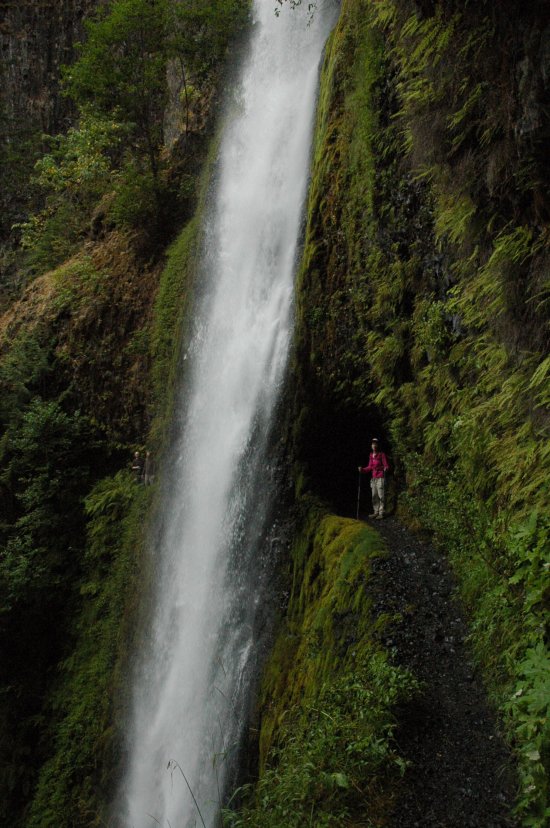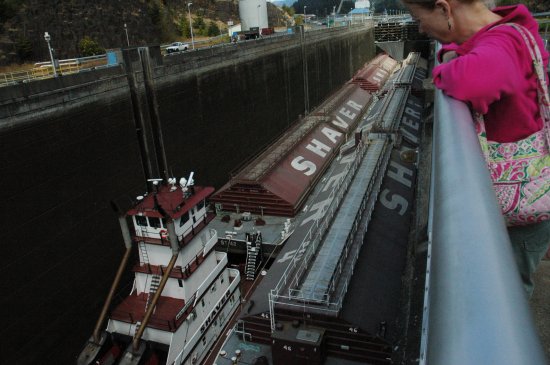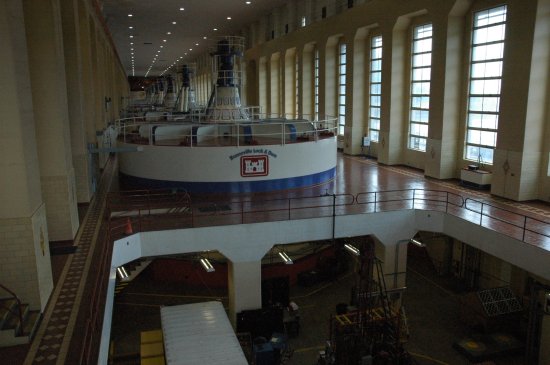Engineering in the Columbia River Gorge
Because yesterday’s hike up Eagle Creek to Tunnel Falls (see picture below) was particularly long, 12.5 miles, I took a break from posting when I got home. Today (Monday), however, was a more easy-going day, as we did more ordinary tourist stuff, driving from place to place with only short strolls at each stop.

The most fascinating tourist stop of the day was by far Bonneville Dam. Just as the security guard at the gate let the car in front of us through, her phone rang. When she was finished and came up to our car, she explained that we would have to wait about a half hour before going to the visitor center, as they needed to open the swing bridge so that a barge could go through the locks. At first I thought this was very unfortunate timing. In the end, it turned out to be fortuitous indeed. We parked at the viewing area above the locks and watched five barges, tied tightly together as a unit and pushed upstream by a tug, slide gently into the lock with barely inches on either side. Neither Diane or I could believe how little spare room the tugboat captain had to pilot this massive object. The gigantic downstream doors then closed (while I quipped that music from Star Wars should be playing) and the lock was quickly filled with water, raising the barges/tugboat up almost a hundred feet. The upstream doors than opened and the barge headed out. All told, the whole operation took less than 45 minutes.


We then took a tour of the dam’s first power station, with its ten turbines all in a row. Unfortunately, none were operating at the moment. Nonetheless, whenever I see places like this (such as when I visited Hoover Dam back in 2005), I can’t help but be reminded of the scene from the science fiction movie Forbidden Planet, when Walter Pigeon gives us a tour of the Krell underground machine. Unlike the Krell, however, it didn’t take millions of years for us to learn how to build such breath-taking big dams and power stations. We did it less than 150 years after the discovery of electricity!

On Christmas Eve 1968 three Americans became the first humans to visit another world. What they did to celebrate was unexpected and profound, and will be remembered throughout all human history. Genesis: the Story of Apollo 8, Robert Zimmerman's classic history of humanity's first journey to another world, tells that story, and it is now available as both an ebook and an audiobook, both with a foreword by Valerie Anders and a new introduction by Robert Zimmerman.
The print edition can be purchased at Amazon or from any other book seller. If you want an autographed copy the price is $60 for the hardback and $45 for the paperback, plus $8 shipping for each. Go here for purchasing details. The ebook is available everywhere for $5.99 (before discount) at amazon, or direct from my ebook publisher, ebookit. If you buy it from ebookit you don't support the big tech companies and the author gets a bigger cut much sooner.
The audiobook is also available at all these vendors, and is also free with a 30-day trial membership to Audible.
"Not simply about one mission, [Genesis] is also the history of America's quest for the moon... Zimmerman has done a masterful job of tying disparate events together into a solid account of one of America's greatest human triumphs."--San Antonio Express-News


…And people wonder why anyone thinks we could do something as complicated as colonizing other worlds or mining asteroids. Heyy we’ve been sculping rivers adn gorges for over a hundred years, whats a silly moonbase!